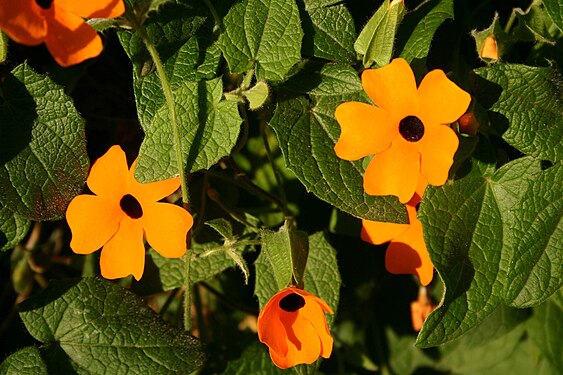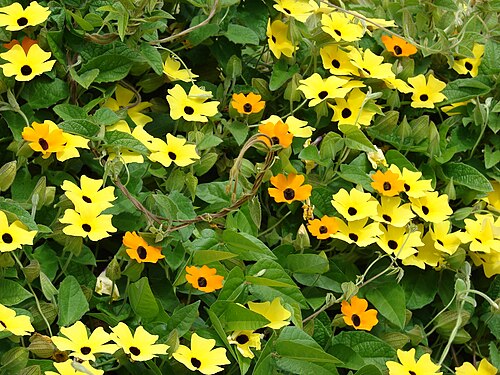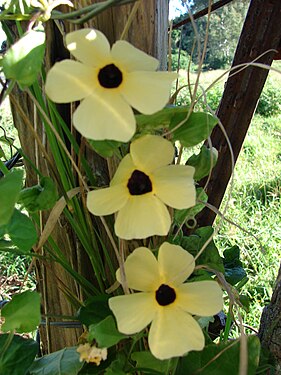Difference between revisions of "Thunbergia alata"
| (5 intermediate revisions by 2 users not shown) | |||
| Line 1: | Line 1: | ||
| + | {{SPlantbox | ||
| + | |familia=Acanthaceae | ||
| + | |genus=Thunbergia | ||
| + | |species=alata | ||
| + | |common_name=Black-eyed Susan vine | ||
| + | |name_ref=Flora - A Gardener's Encyclopedia | ||
| + | |habit=vine-climber | ||
| + | |habit_ref=Flora - A Gardener's Encyclopedia | ||
| + | |Max ht box=10 | ||
| + | |Max ht metric=ft | ||
| + | |height_ref=Flora - A Gardener's Encyclopedia | ||
| + | |Max wd box=10 | ||
| + | |Max wd metric=ft | ||
| + | |width_ref=Flora - A Gardener's Encyclopedia | ||
| + | |lifespan=perennial | ||
| + | |life_ref=Flora - A Gardener's Encyclopedia | ||
| + | |exposure=sun, part-sun | ||
| + | |sun_ref=Flora - A Gardener's Encyclopedia | ||
| + | |features=evergreen, flowers | ||
| + | |flower_season=early summer, mid summer, late summer | ||
| + | |flower_ref=Flora - A Gardener's Encyclopedia | ||
| + | |flowers=orange, yellow | ||
| + | |Temp Metric=°F | ||
| + | |min_zone=10 | ||
| + | |usda_ref=Flora - A Gardener's Encyclopedia | ||
| + | |max_zone=12 | ||
| + | |image=Thunbergia alata00.jpg | ||
| + | |image_width=240 | ||
| + | |image_caption=Black-eyed Susan vine | ||
| + | }} | ||
| + | '''''Thunbergia alata''''', commonly called '''Black-eyed Susan vine''', is a herbaceous perennial climbing plant species in the [[Acanthaceae]] family. It is native to [[Eastern Africa]], and has been naturalized in other parts of the world. It is found in [[Cerrado]] [[vegetation]] of [[Brazil]] and [[Hawaii]], along with eastern [[Australia]] and the southern USA in the states of [[Texas]] and [[Florida]].<ref name=autogenerated2>[http://plants.usda.gov/java/ClassificationServlet?source=profile&symbol=THAL3&display=63 Classification | USDA PLANTS<!-- Bot generated title -->]</ref> It is grown as an [[ornamental plant]] in gardens and in hanging baskets. Black-eyed Susan is also a name given to another species of flowers - [[Rudbeckia]]. | ||
| + | |||
| + | Depending on the conditions,''Thunbergia alata'' grows to a height of 6-8 ft. (1.8-2.4 m) in tropical zones, but much less as a container plant or as an annual. It has twinning stems with heart or arrow-shaped leaves.<ref>http://www.plantzafrica.com/planttuv/thunbergalata.htm</ref> It favours sun to partial shade and the flowers, though typically a warm orange can range through red, orange, red-orange and bright yellow with the characteristic chocolate-purple centre which inspires the common name. | ||
| + | |||
| + | Soft five-petal blooms appear in late Spring/early Summer, mid Summer and again in late Summer, early Autumn (Fall). The leaves are heart shaped [[dicotyledon]]s<ref name=autogenerated2 /> and the plant is an evergreen perennial. | ||
| + | |||
{{Inc| | {{Inc| | ||
| − | Thunbergia alata, Bojer. Black-eyed Susan | + | Thunbergia alata, Bojer. Black-eyed Susan. St. square, climbing, hairy: lvs. opposite, triangular-ovate, hastate, repand-toothed, rough-pubescent, tomentose beneath; petioles winged, about as long as the lvs.: fls. solitary, on axillary peduncles; calyx very small, surrounded by 2 large inflated bracts; corolla-tube somewhat longer than the involucre, dark purple within; limb rotate, oblique, of 5 rounded segms., buff or cream- colored. S. E. Afr. —A perennial climber which may also be treated as an annual greenhouse plant. Usually prop. by seeds. It is used either as greenhouse climber or to grow on trellises outdoors. Outside it flowers mostly in Aug., but by prop. at various times plants may be had in blossom nearly the whole year in the greenhouse. There are many varieties, some of which have been described as species. |
| − | Var. alba, Paxt. (T. alata var. albiflora, Hook.). Fls. white, with a blackish center. | + | Var. alba, Paxt. (T. alata var. albiflora, Hook.). Fls. white, with a blackish center. |
| + | Var. aurantiaca, Kuntze (T. aurantiaca, Paxt.). Fls. bright orange, with a dark center. The best of the group. Subvar. Doddsii has variegated lvs. | ||
| + | Var. Bakeri, Hort. (T. Bakeri or Backerii, Hort.). Fls. pure white. | ||
| + | Var. Fryeri, Hort. (T. Fryeri, Hort. T. alata var. intus-alba, Hort.). Pale orange, with a white center. | ||
| + | Var. sulphurea, Hort. Fls. sulfur-yellow. | ||
| + | Var. lutea, Hort. (T. alata var. unicolor, Hort.). Fls. entirely yellow. | ||
| + | {{SCH}} | ||
}} | }} | ||
| − | + | ==Cultivation== | |
| − | + | {{edit-cult}}<!--- Type cultivation info below this line, then delete this entire line --> | |
| − | + | ||
| − | + | ===Propagation=== | |
| − | + | The plant is self-propagating but propagation methods for gardeners include herbaceous stem cuttings, and from seed. In the northern hemisphere seed is sown indoors before last frost and direct sowing after the last frost of the season. | |
| − | |||
| − | |||
| − | |||
| − | |||
| − | |||
| − | |||
| − | |||
| − | |||
| − | |||
| − | |||
| − | + | To collect seeds, seedheads are allowed to dry on plants before removal and seed collection. | |
| − | == | + | ===Pests and diseases=== |
| − | + | {{edit-pests}}<!--- Type pest/disease info below this line, then delete this entire line --> | |
| − | |||
| − | |||
| − | |||
| − | |||
| − | |||
| − | |||
| − | |||
| − | |||
| − | |||
| − | |||
| − | |||
| − | |||
| − | |||
| − | |||
| − | |||
| − | |||
| − | |||
| − | |||
| − | |||
| − | == | + | ==Species== |
| − | + | <!-- This section should be renamed Cultivars if it appears on a page for a species (rather than genus), or perhaps Varieties if there is a mix of cultivars, species, hybrids, etc --> | |
| − | == | + | ==Gallery== |
| − | + | <gallery perrow=5> | |
| − | + | File:Starr 010419 0035 thunbergia alata.jpg | |
| − | + | File:Thunbergia alata00.jpg | |
| − | + | File:Starr 080716-9357 Thunbergia alata.jpg | |
| − | + | File:Starr 070308-5467 Thunbergia alata.jpg | |
| − | + | File:Starr 070111-3094 Thunbergia alata.jpg | |
| + | File:Arun image10.jpg | ||
| + | </gallery> | ||
| + | ==References== | ||
| + | *[[Standard Cyclopedia of Horticulture]], by L. H. Bailey, MacMillan Co., 1963 | ||
| + | <!--- xxxxx *Flora: The Gardener's Bible, by Sean Hogan. Global Book Publishing, 2003. ISBN 0881925381 --> | ||
| + | <!--- xxxxx *American Horticultural Society: A-Z Encyclopedia of Garden Plants, by Christopher Brickell, Judith D. Zuk. 1996. ISBN 0789419432 --> | ||
| + | <!--- xxxxx *Sunset National Garden Book. Sunset Books, Inc., 1997. ISBN 0376038608 --> | ||
| − | + | ==External links== | |
| − | + | *{{wplink}} | |
| − | |||
| − | {{ | + | {{stub}} |
| − | + | __NOTOC__ | |
Latest revision as of 01:59, 27 April 2010
| Habit | vine-climber
| |
|---|---|---|
| Height: | ⇕ | 10 ft"ft" can not be assigned to a declared number type with value 10. |
| Width: | ⇔ | 10 ft"ft" can not be assigned to a declared number type with value 10. |
| Lifespan: | ⌛ | perennial |
| Bloom: | ❀ | early summer, mid summer, late summer |
| Exposure: | ☼ | sun, part-sun |
|---|---|---|
| Features: | ✓ | evergreen, flowers |
| USDA Zones: | 10 to 12 | |
| Flower features: | ❀ | orange, yellow |
|
alata > |
Thunbergia alata, commonly called Black-eyed Susan vine, is a herbaceous perennial climbing plant species in the Acanthaceae family. It is native to Eastern Africa, and has been naturalized in other parts of the world. It is found in Cerrado vegetation of Brazil and Hawaii, along with eastern Australia and the southern USA in the states of Texas and Florida.[1] It is grown as an ornamental plant in gardens and in hanging baskets. Black-eyed Susan is also a name given to another species of flowers - Rudbeckia.
Depending on the conditions,Thunbergia alata grows to a height of 6-8 ft. (1.8-2.4 m) in tropical zones, but much less as a container plant or as an annual. It has twinning stems with heart or arrow-shaped leaves.[2] It favours sun to partial shade and the flowers, though typically a warm orange can range through red, orange, red-orange and bright yellow with the characteristic chocolate-purple centre which inspires the common name.
Soft five-petal blooms appear in late Spring/early Summer, mid Summer and again in late Summer, early Autumn (Fall). The leaves are heart shaped dicotyledons[1] and the plant is an evergreen perennial.
Read about Thunbergia alata in the Standard Cyclopedia of Horticulture
|
|---|
|
Thunbergia alata, Bojer. Black-eyed Susan. St. square, climbing, hairy: lvs. opposite, triangular-ovate, hastate, repand-toothed, rough-pubescent, tomentose beneath; petioles winged, about as long as the lvs.: fls. solitary, on axillary peduncles; calyx very small, surrounded by 2 large inflated bracts; corolla-tube somewhat longer than the involucre, dark purple within; limb rotate, oblique, of 5 rounded segms., buff or cream- colored. S. E. Afr. —A perennial climber which may also be treated as an annual greenhouse plant. Usually prop. by seeds. It is used either as greenhouse climber or to grow on trellises outdoors. Outside it flowers mostly in Aug., but by prop. at various times plants may be had in blossom nearly the whole year in the greenhouse. There are many varieties, some of which have been described as species. Var. alba, Paxt. (T. alata var. albiflora, Hook.). Fls. white, with a blackish center. Var. aurantiaca, Kuntze (T. aurantiaca, Paxt.). Fls. bright orange, with a dark center. The best of the group. Subvar. Doddsii has variegated lvs. Var. Bakeri, Hort. (T. Bakeri or Backerii, Hort.). Fls. pure white. Var. Fryeri, Hort. (T. Fryeri, Hort. T. alata var. intus-alba, Hort.). Pale orange, with a white center. Var. sulphurea, Hort. Fls. sulfur-yellow. Var. lutea, Hort. (T. alata var. unicolor, Hort.). Fls. entirely yellow. CH
|
Cultivation
- Do you have cultivation info on this plant? Edit this section!
Propagation
The plant is self-propagating but propagation methods for gardeners include herbaceous stem cuttings, and from seed. In the northern hemisphere seed is sown indoors before last frost and direct sowing after the last frost of the season.
To collect seeds, seedheads are allowed to dry on plants before removal and seed collection.
Pests and diseases
- Do you have pest and disease info on this plant? Edit this section!
Species
Gallery
References
- Standard Cyclopedia of Horticulture, by L. H. Bailey, MacMillan Co., 1963
External links
- w:Thunbergia alata. Some of the material on this page may be from Wikipedia, under the Creative Commons license.
- Thunbergia alata QR Code (Size 50, 100, 200, 500)






